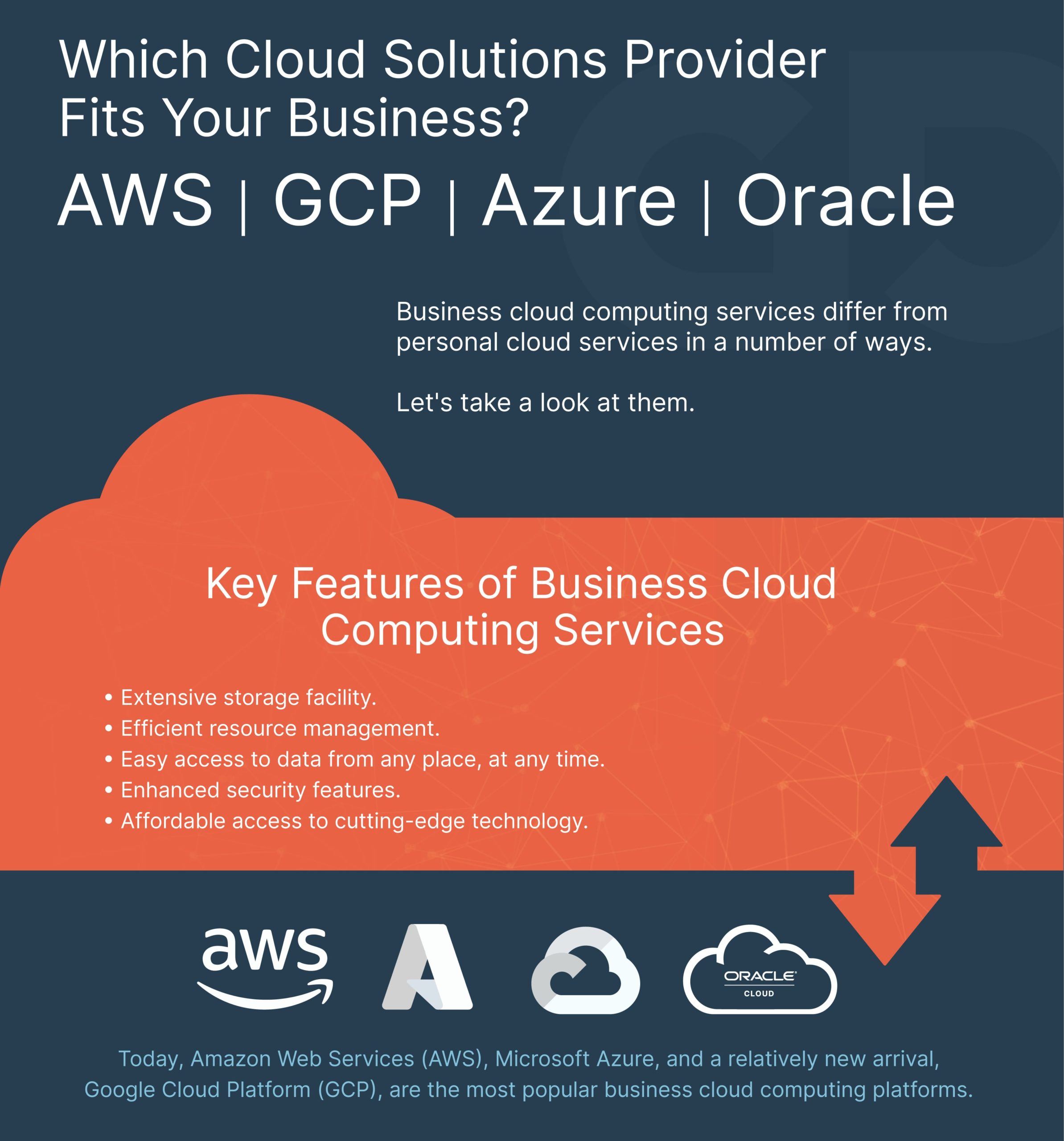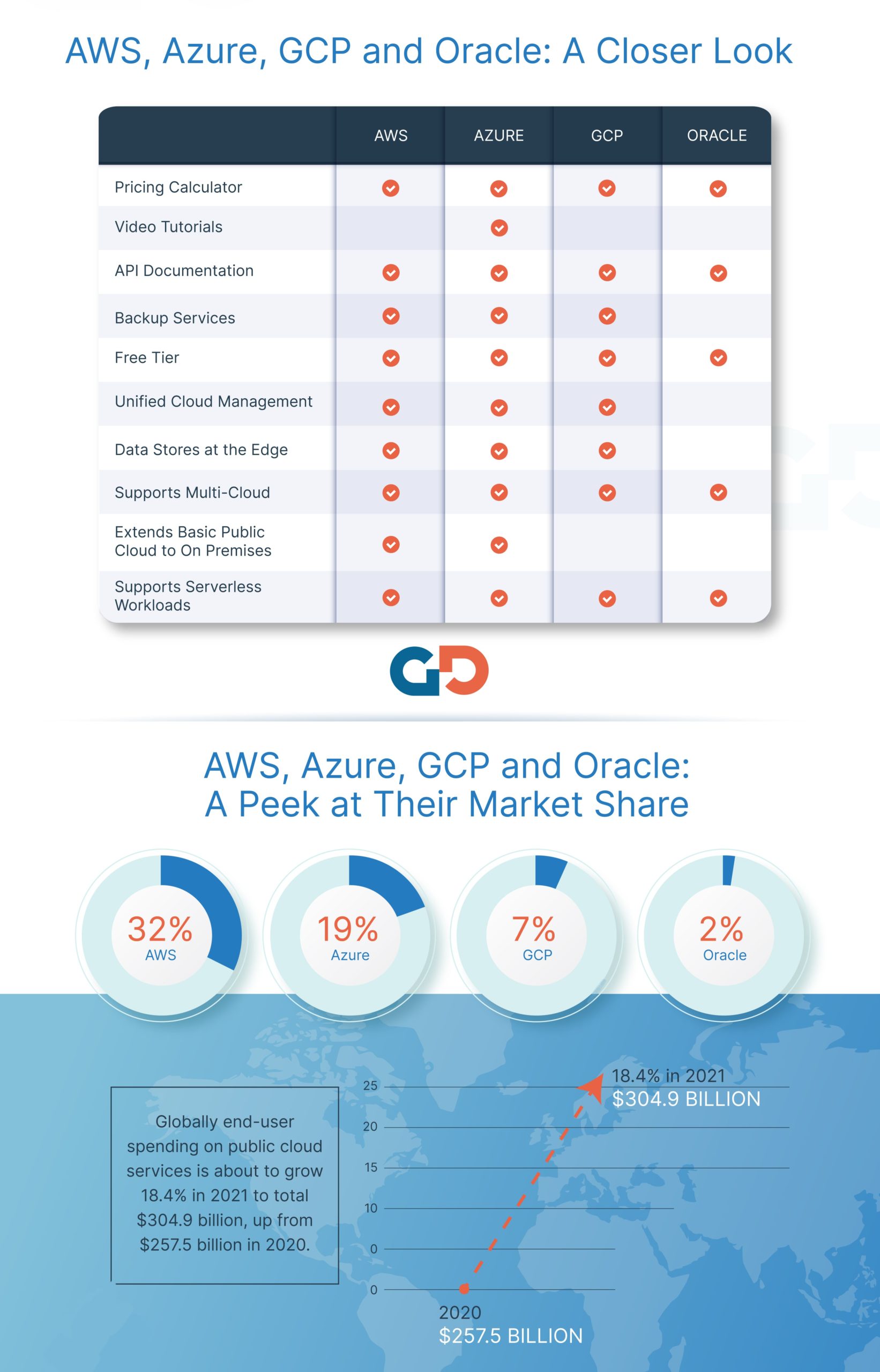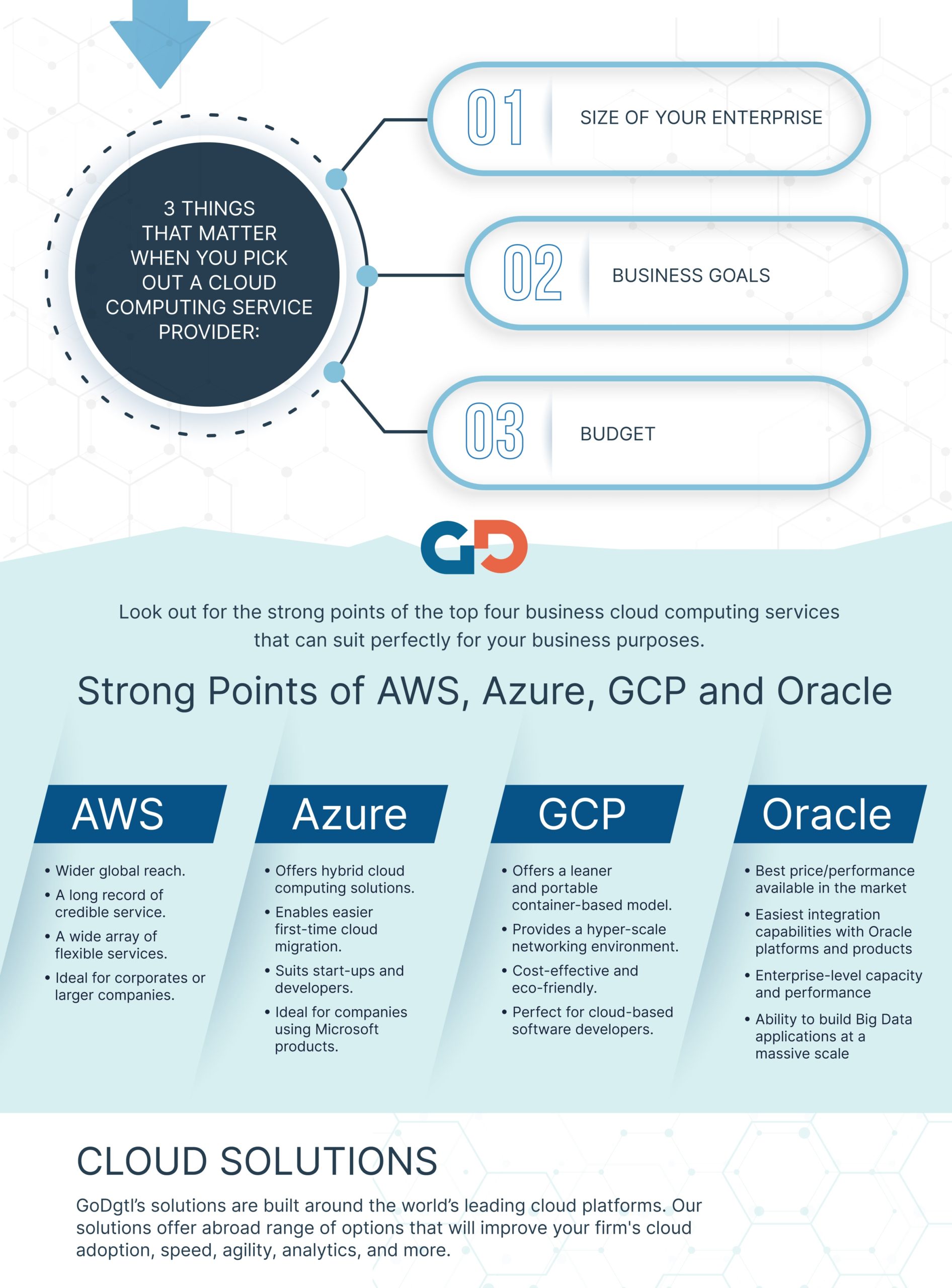Cloud services have certainly grown in the last several years however there are 3 main platforms that stand out amongst the crowd. There is a fierce three-way race between Amazon Web Services vs. Microsoft Azure vs. Google Cloud Platform (GCP). These have become the top cloud companies and have a commanding lead in the markets for Infrastructure as a Service (IaaS), and Platform as a Service (PaaS).
This Gartner magic quadrant shows the dominant position of AWS vs. Microsoft Azure vs. Google Cloud Platform. However, you should expect this graph to change significantly over the years as Alibaba Cloud, Oracle Cloud, and the IBM Cloud will innovate and keep up with the competition and evolve.
AWS has always dominated the cloud space. According to a 2020 report from Synergy Research Group, “Amazon growth continued to closely mirror overall market growth so it maintained its 33% share of the worldwide [cloud] market. Second ranked Microsoft again grew faster than the market and its market share has increased by almost three percentage points in the last four quarters, reaching 18%.”

Meanwhile, Microsoft is particularly strong in SaaS, while Google Cloud, with its strength in artificial intelligence, is positioned for aggressive growth as the AI market grows – and is known for offering discounts.
Let’s take a closer look at the top cloud providers going into 2022.
AWS – Amazon Web Services
AWS being the first to offer true cloud services is the dominating provider. A subsidiary of Amazon and founded in 2006, AWS is a leader amongst cloud service providers. It is one of the first cloud computing platforms that became widely available. Amazon is an IaaS market leader, holding about 31% of the cloud market share. In 2020 the financial results for the entire year exceeded the company’s expectations. Some of this can be attributed to the massive need for cloud services as the pandemic took hold. AWS reported a revenue of $45 billion in 2020, which was almost 30% more than the revenue announced in 2019.
Amazon Web Services offers a broad set of global cloud-based products including compute, storage, databases, analytics, networking, mobile, developer tools, management tools, IoT, security and enterprise applications. These services help organizations move faster, lower IT costs, and scale. AWS is trusted by the largest enterprises and the hottest start-ups to power a wide variety of workloads including: web and mobile applications, game development, data processing and warehousing, storage, archive, and many others.

Where AWS is Strong – (Pros)
When it comes to Iaas and PaaS, AWS has the largest market share and leads in the vast majority of cloud products and services around the globe. A big reason for its popularity is undoubtedly the massive scope of its operations. AWS has a huge and growing array of available services, as well as the most comprehensive network of worldwide data centers. The Gartner report summed it up, saying, “AWS is the most mature, enterprise-ready provider, with the deepest capabilities for governing a large number of users and resources.”
The company has a strong managed service provider network, with 67 premier consulting partners worldwide. Enterprises perceive AWS as a strategic provider of cloud infrastructure. AWS delivers end-to-end solutions, starting from servers to embedded operating systems in Edge devices, and the comprehensive technological stack in between.
Where AWS is Weak – Cons
It is known that one of Amazon’s big weaknesses relates to cost. While AWS regularly lowers its prices, many enterprises find it difficult to understand the company’s cost structure and to manage those costs effectively when running a high volume of workloads on the service. At times Amazon has proclaimed price reductions, the price for some services, like the AWS Compute service, has not become cheaper since 2014. AWS optimizes their best cloud services, and if the customer is tied to the Amazon products, it may not be easy to switch to another service provider although the top 3 majors have made it easier to be friendly with each other in the past few years with cloud agnostic technology coming into favor.
AWS Benefits
Without a doubt, AWS is the most mature and enterprise-ready provider with a tremendous track record of customer success, starting from small and medium businesses to large enterprises. Enterprises using Amazon consistently benefit by being early adopters of new services. Amazon Web Services offers over 100 products that users can test for free. The company provides a set of database, developer and mobile tools and services that are always free. In addition, AWS offers a 1-year trial for certain products and short free trial services for ML, analytics, compute, security and compliance.
Microsoft Azure
Microsoft came later to the cloud market, but gave itself a jump start by essentially taking its on-premises software – Windows Server, Office, SQL Server, Sharepoint, Dynamics Active Directory, .Net, and others – and repurposing it for the cloud.
Microsoft Azure holds a strong second place after AWS. The company provides a broad range of enterprise-focused services. Every quarter Microsoft Azure releases tens of products, services and enhancements resulting from research and development initiatives, made over multiple years. Azure offers the ability to instantly provision computing resources on-demand and is the best-in-class in the hybrid cloud among other cloud vendors.
Microsoft Azure’s market share among IaaS cloud providers is 20%. In Q2 2021, Microsoft Azure’s revenue reached 50% growth when compared to the previous quarter, and resulted in $17 billion in earnings for the company. The accelerated demand for Microsoft Azure offerings has increased by 34% year over year, as stated in the company’s Q2 2021 financial report. Microsoft Enterprise Mobility (service including Microsoft products as Azure Active Directory, Endpoint Configuration Manager, Microsoft Intune, Microsoft Defender, etc.) grew 29% to 163 million seats in Q2 2021.
With over 600 services, Azure has a large layout of cloud offerings. Azure offers VMs as a part of its IaaS offering, Active Directory to synchronize on-premise directories, and enables single sign-on. The company also provides mobile engagement with real-time analytics and tracking of user behaviors and storage services, as well as data management tools such as Azure Data Explorer, Azure SQL Database, Serverless, CDN, Azure AI, Azure Workbench, Azure IoT and other services.
Where Microsoft Azure is Strong – Pros
A big reason for Azure’s success: so many enterprises deploy Windows and other Microsoft software. Because Azure is tightly integrated with these other applications, enterprises that use a lot of Microsoft software often find that it ]makes sense for them to use Azure. This builds loyalty for existing Microsoft customers. Also, if you are already an existing Microsoft enterprise customer, expect significant discounts on service contracts.
There are some good use cases for Azure due in part to the wide service offerings that Microsoft provides. Azure has partnerships with Oracle, VMware and SAP, further extending its capabilities. Microsoft Azure has a strong managed service provider network with 32 partners on its list. On top of that, Microsoft leads the PaaS segment of cloud service providers with a suite of tools, including Azure DevOps and Visual Studio Codespaces (the tool that enables the use of a public cloud and developer tools, such as Visual Studio Code).
Where Microsoft Azure is Weak – Cons
According to Gartner, there is fault with some of the platform’s imperfections. “While Microsoft Azure is an enterprise-ready platform, Gartner clients report that the service experience feels less enterprise-ready than they expected, given Microsoft’s long history as an enterprise vendor,” it said. “Customers cite issues with technical support, documentation, training, and breadth of the ISV partner ecosystem.” These are issues that Microsoft has been trying to improve upon nevertheless customers are still mentioning these issues.

Microsoft support is quite expensive. In addition, Microsoft Azure has a lower ratio of availability zones than other cloud service providers. There’s still room for resilience-centered reengineering efforts and service availability improvements though. On top of that, Azure doesn’t provide any form of guaranteed capacity to its customers, and even pre-paid contracts and reserved instances are not capacity guarantees. During the COVID-19 spike, some Microsoft Azure customers were not able to provision the cloud capacity they had already paid for. There is where AWS outshined its competitors.
Azure Benefits
Azure is particularly well suited for organizations using Microsoft services. Microsoft Azure provides consistent services on the cloud and is a strong player in all use cases. This includes edge and comprehensive cloud offerings, in which other cloud vendors are not that well-versed. Microsoft Azure offers a $200 credit for 30 days to new users. As mentioned earlier, Azure offers the ability to instantly provision computing resources on-demand and is the best-in-class in the hybrid cloud among other cloud vendors.
Google Cloud Platform (GCP)
Google Cloud has third place on Gartner’s Magic Quadrant of cloud providers, after AWS and Microsoft Azure. In the last year, Google Cloud has substantially increased its hybrid and multi-cloud workload using Antos which allows users to manage workloads on Google, AWS and Azure. Besides, Firebase, a Google-purchased cloud mobile Backend-as-a-Service (BaaS), has grown quite rapidly and became widely adopted by developers. Firebase remains a highly-demanded BaaS platform despite it being run on the top of Google Cloud.
The market share of Google Cloud in infrastructure, as a service market, is 7%. In 2020 Google was investing heavily in sales staff, resulting in an operating loss of $5 billion and an overall $13 billion revenue. However, these steps were needed to scale the business and improve its profitability.
The Google Cloud platform offers 100 products that can be grouped into six categories: storage, databases, computing and hosting (servers, containers VMs), networking (VPC, load balancing, cloud DNS), big data (Big Query for data analysis, Dataflow for batch and streaming data processing), and machine learning (AI platform).
Where Google Cloud is strong – Pros
Google Cloud stands out in big data, machine learning and data science capabilities with its products like TensorFlow, ML Kit and Google Datasets. It offers an end-to-end AI platform built on the latest technologies and is enabled by tools like TensorFlow and TPUs (Tensor Processing Unit – an AI accelerator application-specific integrated circuit).
Google has a strong offering in containers since Google developed the Kubernetes standard that AWS and Azure now offer. GCP specializes in high compute offerings like Big Data, analytics, and machine learning. It also offers considerable scale and load balancing – Google knows data centers and fast response time.
Where Google Cloud is weak – Cons
Google has challenges with positioning itself as an enterprise-class IaaS solution. Its offerings have not yet reached the level of enterprise maturity that AWS and Microsoft Azure provide, and some of them are not yet as fully packaged as the ones offered by Google Cloud’s rivals. Likewise, Google Cloud has a smaller pool of well-versed managed service providers than other cloud vendors. Google is a distant third in market share, perhaps because it doesn’t have the traditional relationship with enterprise customers. However, it is quickly expanding both its offerings and its footprint of global data centers.
Gartner said that its “clients typically choose GCP as a secondary provider rather than a strategic provider, though GCP is increasingly chosen as a strategic alternative to AWS by customers whose businesses compete with Amazon, and that are more open-source-centric or DevOps-centric, and thus are less well-aligned to Microsoft Azure.”

Google Cloud Benefits
Research shows that Google Cloud customers don’t need to be afraid of the vendor lock-in since the main Google offerings are open source (Kubernetes, TensorFlow and Istio) which eventually became industry standards. These services have significantly influenced the deployment, scaling and management of enterprise IT in the cloud. As the cloud industry and platforms evolve towards cloud agnostic offerings, Google is increasing, though slowly, its market footprint every year by convincing customers with its enterprise cloud offerings which are starting to stand up to industry standards in a convincing way.
Where Are the Trends Going into 2022?
According to predictions from Gartner, global spending on cloud services is expected to reach over $482 billion in 2022, up from $313 billion in 2020. Cloud computing infrastructure is the backbone of the delivery pipeline of just about every digital service, from social media and streaming entertainment to connected cars and autonomous internet of things (IoT) infrastructure. New or upcoming ultra-fast networks like 5G and Wi-Fi 6E don’t just mean more data will be streamed from the cloud; they mean new types of data can be streamed.
The pandemic brought about an explosion in cloud usage for employee remote services and those trends will continue to evolve and enterprise migrations will become more focused and projects will begin to use hybrid cloud. The distinction between public and private cloud will become less as options for ‘best of both worlds’ start to become frequent offerings.
How GoDgtl Partners with AWS, Azure, and Google Cloud Services
GoDgtl brings a team of experienced cloud experts who work directly with AWS, Azure, and Google to bring value and real solutions for your cloud projects. With direct access to resources and in-house cloud consulting talent, GoDgtl is ready to guide you through your cloud (security) journey regardless of where you are on that path. Whether it’s more knowledge-based information on cloud topics such as security, or governance and compliance or basic cloud migration aspects or even if an assessment is needed, GoDgtl can provide a roadmap for your path to project completion and success.
Sources:
https://www.avenga.com/magazine/top-cloud-service-providers/
https://www.datamation.com/cloud/aws-vs-azure-vs-google-cloud/
Recent Posts
Let's Talk
Our GoDgtl team is ready to help you!
We appreciate your interest in GoDgtl. Please select which team of experts you wish to engage: